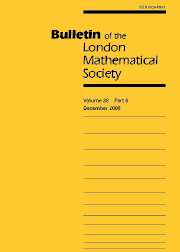Article contents
PROBLEMS IN THE STEENROD ALGEBRA
Published online by Cambridge University Press: 01 September 1998
Abstract
This article contains a collection of results and problems about the Steenrod algebra and related algebras acting on polynomials which non-specialists in topology may find of some interest. Although there are topological allusions throughout the article, the emphasis is on the algebraic development of the Steenrod algebra and its connections to the various topics indicated below.
Contents
1 Historical background 452
2 Differential operators and integral Steenrod squares 460
3 Symmetric functions and differential operators 471
4 Bases, excess and conjugates 476
5 The stripping technique 483
6 Iteration theory and nilpotence 490
7 The hit problem and invariant theory 495
8 The dual of [Ascr ](n) and graph theory 504
9 The Steenrod group 507
10 Computing in the Steenrod algebra 508
References 511
In Section 1 the scene is set with a few remarks on the early history of the Steenrod algebra [Ascr ] at the prime 2 from a topologist's point of view, which puts into context some of the problems posed later. In Section 2 the subject is recast in an algebraic framework, by citing recent work on integral versions of the Steenrod algebra defined in terms of differential operators. In Section 3 there is an explanation of how the divided differential operator algebra [Dscr ] relates to the classical theory of symmetric functions. In Section 4 some comments are made on a few of the recently discovered bases for the Steenrod algebra. The stripping technique in Section 5 refers to a standard action of a Hopf algebra on its dual, which is particularly useful in the case of the Steenrod algebra for deriving relations from relations when implemented on suitable bases. In Section 6 a parallel is drawn between certain elementary aspects of the iteration theory of quadratic polynomials and problems about the nilpotence height of families of elements in the Steenrod algebra. The hit problem in Section 7 refers to the general question in algebra of finding necessary and sufficient conditions for an element in a graded module over a graded ring to be decomposable into elements of lower grading. Equivariant versions of this problem with respect to general linear groups over finite fields have attracted attention in the case of the Steenrod algebra acting on polynomials. Similar problems arise with respect to the symmetric groups and the algebra [Dscr ]. This subject relates to topics in classical invariant theory and modular representation theory. In Section 8 a number of statements about the dual Steenrod algebra are transcribed into the language of graph theory. In Section 9 a standard method is employed for passing from a nilpotent algebra over a finite field of characteristic p to a p-group, and questions are raised about the locally finite 2-groups that arise in this way from the Steenrod algebra. Finally, in Section 10 there are a few comments on the use of a computer in evaluating expressions and testing relations in the Steenrod algebra.
- Type
- SPECIAL ARTICLE
- Information
- Copyright
- © The London Mathematical Society 1998
- 34
- Cited by


